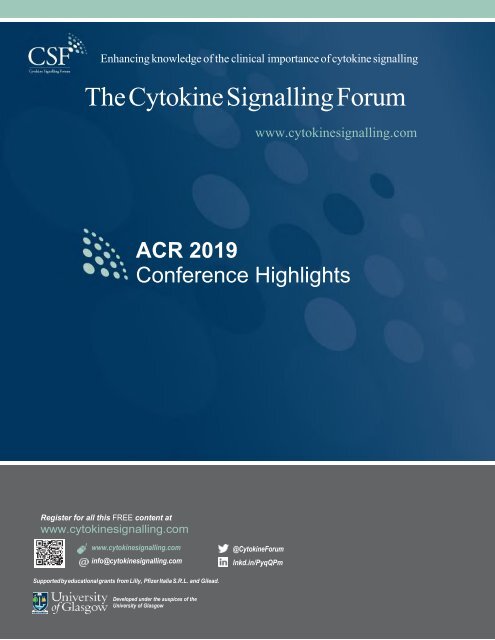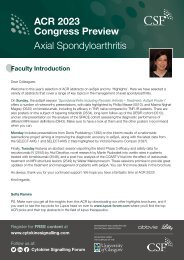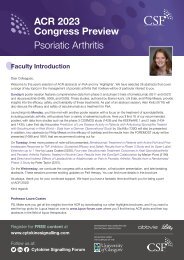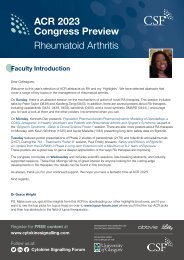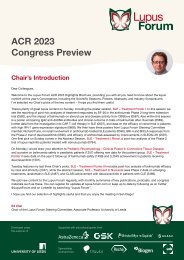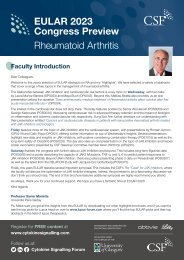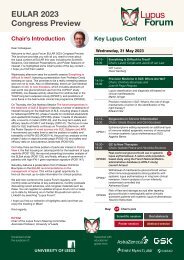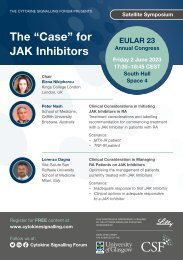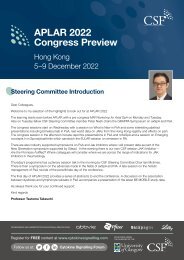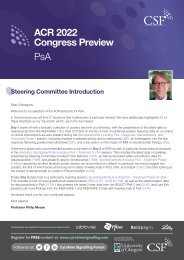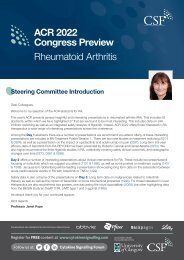ACR Congress Review 2019
You also want an ePaper? Increase the reach of your titles
YUMPU automatically turns print PDFs into web optimized ePapers that Google loves.
Enhancing knowledge of the clinical importance of cytokine signalling<br />
The Cytokine Signalling Forum<br />
www.cytokinesignalling.com<br />
<strong>ACR</strong> <strong>2019</strong><br />
Conference Highlights
<strong>ACR</strong> <strong>2019</strong><br />
Conference Highlights<br />
Chairman’s Welcome<br />
Dear CSF Member,<br />
Welcome to this year’s selection of <strong>ACR</strong> abstracts on cytokine signalling agents and my ‘Chairman’s picks’.<br />
As in previous years, there continued to be an intense focus on the Janus kinase (JAK) inhibitors, with late stage trial results<br />
from filgotinib, peficitinib and newly approved upadacitinib – as well as a host of real-world and trial data for the more<br />
established baricitinib and tofacitinib.<br />
The largest number of trial abstracts concern upadacitinib. Key among them are the 48-week data from SELECT<br />
MONOTHERAPY [513], SELECT-EARLY [928] and 60-week data from SELECT BEYOND [518], and SELECT NEXT [538].<br />
There is an interesting study analysing the clinical and functional outcomes of switching between upadacitinib and<br />
adalimumab following initial non-response [2907] and another looking into structural joint damage inhibition with upadacitinib<br />
monotherapy and combination use [547].<br />
For filgotinib, Combe et al and Westhovens et al presented data from the FINCH trials [506; 927], whilst Takeuchi et al<br />
presented data on the inhibition of joint destruction with peficitinib in combination with methotrexate [507].<br />
There is new clinical data for both tofacitinib and baricitinib – with a phase 3 study assessing disease trajectories in baricitinib<br />
patients [1350], and a look at MTX-withdrawal in patients taking the extended-release formulation of tofacitinib [1412].<br />
Real-world studies examined the utility of these two drugs in clinical practice, exploring the impact of time since first<br />
diagnosis on tofacitinib [1484] and an updated baricitinib safety profile with patients exposed for up to 7 years [847].<br />
At this year’s congress there was a focus on safety and patient reported outcomes, with pain relief in patients investigated<br />
for both baricitinib [1407] and tofacitinib [1502]. MACE and VTEs are also in the spotlight with meta analyses across JAK<br />
inhibitors [2358] and data for upadacitinib [846] being presented.<br />
We also saw Phase 2 data from Bruton’s tyrosine kinase (BTK) inhibitor fenebrutinib [929]. It will be important to see how<br />
these agents progress over the coming years, and to find out what hope they can offer to patients who fail on current<br />
therapies.<br />
Within the following pages, we share our selection of the congress highlights, including my ‘Chairman’s picks’. As always,<br />
thank you for your continued support, and we hope you enjoyed your time in Atlanta at <strong>ACR</strong> <strong>2019</strong>!<br />
Kind regards,<br />
Prof. Iain McInnes
Highlights from <strong>ACR</strong> <strong>2019</strong><br />
During the <strong>ACR</strong> <strong>2019</strong> annual meeting, many presentations and posters reported on cytokine signalling<br />
and related drugs. This document reviews the highlights.<br />
NOVEL TREATMENTS – Clinical Trials<br />
Filgotinib<br />
Filgotinib Phase 3 studies in RA patients – FINCH1 and FINCH3<br />
Combe and colleagues presented the primary outcome results from the Phase 3, double-blind,<br />
active- and placebo-controlled FINCH1 study evaluating filgotinib versus adalimumab or placebo in<br />
patients with active RA and an inadequate response to MTX. The study randomised 1,759 patients, of<br />
whom 1,755 received study drug and were analysed (filgotinib 200 mg QD, n=475; filgotinib 100 mg QD,<br />
n=480; adalimumab 40 mg Q2W, n=325; placebo, n=475). At Week 12, significantly more patients in the<br />
filgotinib 200 mg and 100 mg arms achieved an <strong>ACR</strong>20 response compared with placebo (76.6%,<br />
69.8% and 49.9%, respectively). Similarly, compared to placebo, more patients receiving filgotinib<br />
achieved <strong>ACR</strong>50 and <strong>ACR</strong>70 responses, DAS28-CRP scores ≤3.2 and
corticosteroids, and different classes of DMARDs on filgotinib efficacy as measured by <strong>ACR</strong>20 and<br />
DAS28(CRP). Of the 448 patients randomised and treated at baseline, 80.4% were female with a mean<br />
age of 56 years and a mean RA duration of 12.4 years. Benefits were observed for filgotinib across<br />
subgroups. Notably, there was an absence of impact of disease duration, seropositivity, disease activity<br />
and concurrent medication use, on the effectiveness of filgotinib [504].<br />
Genovese et al. evaluated the efficacy of filgotinib in FINCH2 based on number and mechanism of<br />
action (MOA) of prior biologics. Prior bDMARD exposure, including the total number and MOA, was well<br />
balanced amongst the 3 treatment arms. Compared with placebo, filgotinib demonstrated improved<br />
clinical outcomes in bDMARD refractory patients. The efficacy observed with filgotinib was maintained<br />
with no significant effects based on the number and MOA of prior bDMARD use, including in patients<br />
with prior exposure to IL-6 inhibitors [517].<br />
A third analysis of FINCH2, which investigated the extent of anaemia, thrombocytopenia and leukopenia,<br />
was also presented by Genovese and colleagues. Overall, haemoglobin levels, platelet, lymphocyte and<br />
neutrophil counts remained consistent throughout the study. At baseline, 28.8%, 0.9%, 2.2% and 5.8%<br />
patients had mild-moderate low levels of haemoglobin, platelet, neutrophil and lymphocyte, respectively,<br />
and 1.1% had severely low levels of lymphocytes. Of the patients with mild-moderate haemoglobin<br />
levels at baseline, 13.1% with filgotinib 200 mg, 9.5% with filgotinib 100 mg, and 7.6% with placebo<br />
achieved normal haemoglobin at Week 24. All patients with baseline mild-moderate low platelets and<br />
neutrophils had normal levels at Week 24, except for one patient with mild neutropenia receiving<br />
filgotinib 100 mg. Of the patients with normal platelet and neutrophil levels at baseline, >94% maintained<br />
normal levels at Week 24 in all treatment groups. The authors summarised that most patients with<br />
normal haemoglobin, platelet, lymphocyte and neutrophil levels at baseline maintained them over 24<br />
weeks of filgotinib treatment. Overall, the results suggest that filgotinib does not increase the incidence<br />
of anaemia, thrombocytopenia or leukopenia in patients who entered the study with active RA despite<br />
prior biologic therapies [2875].<br />
Modulation of disease-associated cytokines with filgotinib<br />
Taylor and colleagues presented three analyses of disease-associated cytokines in the FINCH2 study.<br />
Cytokine profiles were compared with those of 50 demographically matched healthy volunteers in a<br />
transcriptomic and proteomic study of serum samples from 449 patients. Among 28 cytokines evaluated<br />
in baseline RA serum, 18 were significantly different from healthy volunteers. Of these, CXCL13, CCL2,<br />
CCL3, CCL4, IL-18 and osteocalcin reversed toward healthy volunteer phenotype after filgotinib<br />
treatment, whereas only IL-18 reached healthy volunteer levels in placebo-treated patients. The baseline<br />
transcriptional profile of RA patients was enriched with pathways implicated in RA pathology, including<br />
inflammatory responses and IFN, IL-6, TNFα signalling. Reversal of transcriptional profiles was broadly<br />
dose- and time-dependent, with fewer genes differentially expressed from healthy volunteers after 12<br />
weeks of filgotinib versus placebo. In summary, differences in the peripheral molecular profile were<br />
observed between bDMARD-experienced RA patients and healthy volunteers. While an overall trend<br />
toward the non-diseased molecular profile was observed following filgotinib, only a subset of cytokines<br />
and pathways were statistically indistinguishable from healthy volunteers after 12 weeks [45].<br />
Data from a longitudinal study of cytokines in blood and urine samples from FINCH2 RA patients were<br />
also presented. Comparing filgotinib 100 mg to placebo, high baseline serum levels of CCL3, CXCL10,<br />
IL-5, IL-6, IL-18, MMP3, SAA and VCAM1 were individually associated with improved <strong>ACR</strong> response or<br />
reduction in RA activity (DAS28-CRP) at Week 12. High baseline serum CRP, CXCL13 and VEGFA<br />
levels were also associated with improved response to filgotinib 200 mg. In placebo-treated patients, a<br />
low sICAM1/CXCL13 ratio led to a lower <strong>ACR</strong>50 response rate than those with a high ratio. In contrast,<br />
in filgotinib-treated patients, a low sICAM1/CXCL13 ratio led to an improved <strong>ACR</strong>50 response.<br />
*Chairman’s Pick
In summary, individually, high baseline levels of key inflammatory serum cytokines, as well as the<br />
presence of a low sICAM1/CXCL13 ratio, were each indicative of positive outcomes in bDMARD-IR RA<br />
patients treated with filgotinib [46*].<br />
Finally, Taylor and colleagues presented results of an RNA sequencing study that examined the value of<br />
baseline gene expression for predicting therapeutic response to filgotinib in patients from FINCH2.<br />
Baseline Rodriguez-Carrio IFN signature score showed no significant association with Week 12 clinical<br />
response (P>0.05 for all comparisons). In contrast, the baseline FINCH2-derived composite IFN-based<br />
signature was significantly associated with an increase of DAS28-CRP after 12 weeks (P=0.0026),<br />
independent of treatment. The composite IFN-based signature score was significantly associated with a<br />
filgotinib-specific improvement in DAS28-CRP (100 mg, P=0.0045; 200 mg, P=0.0005) and <strong>ACR</strong>-N<br />
responses (100 mg, P=0.036) after 12 weeks. The authors concluded that IFN signalling alone is not<br />
sufficient to predict response to MTX in a bDMARD experienced population. However, an expanded<br />
FINCH2-derived composite IFN signature demonstrated a treatment-specific significant association at<br />
Week 12 [2012].<br />
Effect of filgotinib on cholesteryl ester transfer protein levels in RA patients<br />
Di Paolo and colleagues presented findings on the in vitro profiles of JAKis as evaluated using human<br />
cell-based assays and pharmacokinetic-pharmacodynamic models. Filgotinib 100 and 200 mg resulted<br />
in lower calculated cellular inhibition than the other JAKis at clinical exposures. Notably, filgotinib 100 mg<br />
and 200 mg were calculated to reduce cholesteryl ester transfer protein (CETP) expression by 17.3%<br />
and 27.4%, respectively. Baricitinib, tofacitinib, and upadacitinib did not alter CETP levels. These results<br />
provide a potential mechanistic link to the observed reduction of CETP concentration and activity<br />
following filgotinib treatment, and the associated observed reduction in LDL:HDL in RA patients [59*].<br />
Peficitinib<br />
Interim results of peficitinib a long-term open-label extension study<br />
Takeuchi and colleagues presented the interim results of a long-term open-label extension study of<br />
peficitinib (NCT01638013) conducted in Japan, Korea and Taiwan. Patients who had previously<br />
completed Phase 2b or Phase 3 studies (RAJ1/3/4) received oral peficitinib (50, 100 or 150 mg) once<br />
daily. Starting dose was 100 mg (RAJ3/4) or 50 mg (RAJ1). Doses could be increased to 150 mg/day or<br />
reduced (from 100 mg/day or 150 mg/day) to 50 mg/day according to clinical response and safety<br />
assessment, as judged by the investigator. A total of 843 patients received peficitinib (RAJ1, n=201;<br />
RAJ3, n=225; RAJ4, n=417) with a mean treatment exposure of 22.7 months. During long-term<br />
treatment, <strong>ACR</strong>20 responses were maintained from baseline for patients receiving maximum doses of<br />
100/150 mg/day and were improved then maintained in patients receiving maximum doses of<br />
50 mg/day. <strong>ACR</strong> components and DAS28-CRP also demonstrated continuous improvements from the<br />
baselines of preceding studies. TEAEs were reported in 89.8% of patients and were primarily grade 1/2<br />
in severity; the most common were nasopharyngitis, RA and herpes zoster. Rates of AEs of special<br />
interest (serious infections, herpes zoster-related disease and malignancies) were greater for patients<br />
from RAJ3/4 than RAJ1. There was no evidence to support a trend towards increasing incidence<br />
rate/100 patient years with treatment duration. One death during and one death after the study were<br />
considered probably and possibly related to study drug, respectively. The authors concluded that no<br />
additional safety concerns were observed with longer term administration of peficitinib in RA patients,<br />
and efficacy was maintained for the study duration [508].<br />
*Chairman’s Pick
Suppression of joint destruction with peficitinib<br />
A secondary analysis evaluating the suppression of join destruction with peficitinib was presented by<br />
Takeuchi and colleagues. This Phase 3 trial (NCT02305849) examined the efficacy and safety of a<br />
peficitinib-MTX combination in patients with RA who had an inadequate response to MTX. A total of 518<br />
patients were included in the analysis: placebo (n=170), peficitinib 100 mg/day (n=174) and peficitinib<br />
150 mg/day (n=174). Sensitivity analyses showed that the change in mTSS at Week 28 was similar to<br />
the primary analysis result, demonstrating the robustness of the primary analysis. At Week 28, a<br />
significantly greater proportion of patients achieved a change in mTSS of ≤0.5 with both peficitinib 100<br />
and 150 mg/day compared with placebo (67.1% and 72.6% versus 45.8%, respectively; P
treatment with MTX. A total of 1629 patients were randomised to upadacitinib 15 mg QD, placebo, or<br />
adalimumab 40 mg EOW, while continuing stable background MTX. Rescue therapy was offered based<br />
on predefined clinical criteria at Weeks 14 to 26 and all patients receiving placebo who were not rescued<br />
were switched to upadacitinib at Week 26. Between Weeks 14 and 26, 38.7% of patients randomised to<br />
upadacitinib and 48.6% of patients randomised to adalimumab were rescued. At Week 26, and Week<br />
48, significantly more patients in the upadacitinib versus adalimumab group achieved <strong>ACR</strong>20/50/70, low<br />
disease activity and remission; this was also true for visits between Weeks 26 and 48. Similarly,<br />
improvements in pain and function were significantly greater in the upadacitinib versus adalimumab<br />
group through Week 48. At Week 26, there was significantly less radiographic progression for<br />
upadacitinib versus placebo, which was maintained through Week 48 based on linear extrapolation.<br />
Safety was consistent with observations in the first 26 weeks. The rate of AEs leading to discontinuation<br />
was higher with “any adalimumab” versus “any upadacitinib”, while the rate of herpes zoster was higher<br />
with “any upadacitinib” exposure. In summary, upadacitinib continued to demonstrate superior clinical<br />
and functional responses compared with adalimumab through Week 48 [527].<br />
Sixty-week results from the ongoing extension of the Phase 3 SELECT-NEXT study were presented by<br />
Burmester and colleagues. In SELECT-NEXT, patients with moderately-to-severely active RA and an<br />
inadequate response to csDMARDs received once-daily upadacitinib 15 mg, upadacitinib 30 mg or<br />
placebo for 12 weeks on stable background csDMARDs. At Week 12, the start of the long-term blinded<br />
extension, patients initially randomised to placebo were switched to upadacitinib 15 mg or 30 mg per<br />
pre-specified assignment at baseline. Patients initially assigned to upadacitinib continued their assigned<br />
dose; no dose adjustments were permitted, but adjustments to background RA medications were<br />
permitted from Week 24. Ninety-two percent of patients completed Week 12 and continued onto the<br />
extension. Based on an “As Observed” analysis, for patients who continued on upadacitinib 15 mg<br />
(85%) and upadacitinib 30 mg (81%), clinical and functional outcomes continued to improve or were<br />
maintained through Week 60, with 59% and 56% of patients in these groups achieving<br />
DAS28-CRP
1114 patients were included, of whom 648 received monotherapy in SELECT-MONOTHERAPY and 466<br />
received combination therapy in SELECT-NEXT. In these cohorts of patients with RA and an inadequate<br />
response to MTX, both upadacitinib monotherapy and upadacitinib combination therapy led to significant<br />
improvements in efficacy outcomes versus continued MTX or placebo plus MTX. No significant<br />
differences were observed between upadacitinib monotherapy and upadacitinib combination therapy<br />
across a range of clinical endpoints including <strong>ACR</strong>20/50/70 responses and measures of LDA and<br />
remission. In addition, improvements in quality of life as measured by HAQ-DI were similar with<br />
upadacitinib monotherapy and combination therapy. The authors concluded that in MTX-IR RA patients,<br />
the efficacy of upadacitinib appears comparable when administered as monotherapy or when given in<br />
combination with MTX [511*].<br />
Kapetanovic and colleagues presented a post-hoc analysis of the SELECT-EARLY study results to<br />
examine the effect of receiving upadacitinib treatment within 3 months of treatment. A total of 270<br />
patients started treatment within 90 days from RA diagnosis (median: 44 days). At Week 24, compared<br />
to MTX, significantly greater proportions of patients receiving upadacitinib 15 or 30 mg monotherapy<br />
achieved efficacy outcomes including <strong>ACR</strong>20, 50 and 70 responses, DAS28CRP
Individual and composite measures of disease activity in patients with RA treated with upadacitinib or<br />
comparators were presented by van Vollenhoven and colleagues. The analyses included patients who<br />
were MTX naïve (SELECT-EARLY, n=947) or MTX-IR (SELECT-COMPARE, n=1629). Responses at<br />
Week 12 were defined as ≥50% improvement in the 7 components of the <strong>ACR</strong> response criteria. In<br />
MTX-naïve and MTX-IR patients, treatment responses at 12 weeks occurred in significantly higher<br />
proportions of patients receiving upadacitinib monotherapy versus MTX and upadacitinib plus MTX<br />
versus placebo for all 7 components of the <strong>ACR</strong> response criteria, and for 5 of 7 <strong>ACR</strong> components for<br />
upadacitinib plus MTX versus adalimumab plus MTX. Favourable outcomes with upadacitinib treatment<br />
were evident both in composite and individual parameters [523].<br />
Kremer and colleagues presented the comparative efficacy of upadacitinib in combination with MTX<br />
versus upadacitinib in combination with other csDMARDs. Analyses were performed using data from the<br />
SELECT-NEXT and SELECT-BEYOND trials, in which 535 and 410 patients, respectively, received<br />
concomitant MTX (mean dose 17 mg/week), and 124 and 82 patients received non-MTX csDMARDs.<br />
Across all subgroups, the proportion of patients achieving efficacy outcomes was higher with both<br />
upadacitinib doses compared with placebo. There were no significant differences between efficacy<br />
outcomes with upadacitinib in combination with MTX versus upadacitinib in combination with non-MTX<br />
csDMARDs in either patient population; this included <strong>ACR</strong>20 response as well as LDA and remission<br />
defined by DAS28-CRP and CDAI. In summary, the efficacy of upadacitinib in patients with RA<br />
appeared comparable whether administered in combination with MTX or non-MTX csDMARDs [524*].<br />
Hall and colleagues presented remission rates in patients with RA treated with upadacitinib or<br />
comparators. The analyses included patients who were MTX naïve (SELECT-EARLY, n=945), MTX-IR<br />
(SELECT-COMPARE, n=1629) and bDMARD-IR (SELECT-BEYOND, n=498). At 12 weeks, in<br />
SELECT-EARLY and SELECT-COMPARE, a significantly greater proportion of patients receiving<br />
upadacitinib 15 or 30 mg QD achieved remission by all four definitions versus MTX, placebo or<br />
adalimumab. In SELECT-BEYOND, (a refractory population many of whom had an inadequate response<br />
to multiple bDMARDs), a significantly greater proportion of patients receiving upadacitinib 30 mg<br />
achieved all remission definitions versus placebo within the first 12 weeks and rates of remission further<br />
increased through Week 24 for both dose groups. All disease activity components of each remission<br />
definition were significantly improved in patients receiving upadacitinib compared to MTX or placebo,<br />
and all Boolean components were significantly improved in patients receiving upadacitinib 15 mg<br />
compared with adalimumab [529].<br />
An evaluation of structural joint damage progression through Week 48 in patients with moderately to<br />
severely active RA treated with upadacitinib monotherapy or in combination with MTX was presented by<br />
Peterfy and colleagues. The analysis included patients from SELECT-EARLY (n=945) and<br />
SELECT-COMPARE (n=1629). At Weeks 24/26, upadacitinib as monotherapy and in combination with<br />
background MTX significantly inhibited radiographic progression (measured by mean ΔmTSS) and the<br />
proportion of patients with no radiographic progression versus MTX and placebo, respectively. The<br />
significant inhibition of radiographic progression with upadacitinib was maintained through Week 48<br />
versus MTX in SELECT-EARLY and versus placebo in SELECT-COMPARE. Following the switch of all<br />
placebo patients to upadacitinib in SELECT-COMPARE by Week 26, no further change in mean mTSS<br />
was observed through Week 48. In summary, upadacitinib both as monotherapy, and in combination<br />
with background MTX, was effective in inhibiting the progression of structural joint damage through<br />
Week 48 in MTX-naïve, and MTX-IR patients, respectively [547*].<br />
Fleischmann and colleagues presented outcomes associated with a treatment switch from upadacitinib<br />
to adalimumab and vice-versa among MTX-IR RA patients who were non-responders or partial<br />
responders in a Phase 3 study of upadacitinib 15 mg QD versus placebo or adalimumab 40 mg injection<br />
EOW. Of the 651 and 327 patients randomised to receive upadacitinib and adalimumab, 39% were<br />
switched from upadacitinib to adalimumab and 49% were switched from adalimumab to upadacitinib.<br />
*Chairman’s Pick
At 6 months post-switch, patients switched to adalimumab achieved 69%, 37%, 16% improvements in<br />
<strong>ACR</strong>20/50/70 responses, and 40% and 21% achieved DAS28-CRP≤3.2 and ≤2.6. Patients switched to<br />
upadacitinib achieved 81%, 56%, 32% improvements in <strong>ACR</strong>20/50/70, and 56% and 35% achieved<br />
DAS28-CRP≤3.2 and ≤2.6 at 6 months. Mean changes from the original baseline in HAQ-DI were -0.58<br />
and -0.73 for patients switching to adalimumab and upadacitinib, respectively. The proportions of<br />
patients with infection and serious infection through 6 months post-switching appeared consistent with<br />
those observed for adalimumab and upadacitinib during comparable periods. The authors concluded<br />
that patients with initial non-response to either upadacitinib or adalimumab can benefit from switching to<br />
the other therapy [2907*].<br />
Effects of upadacitinib on reverse cholesterol transport<br />
Charles-Schoeman and colleagues presented findings on the effect of upadacitinib treatment on<br />
cholesterol efflux capacity (CEC) and the association of CEC with changes in inflammation and serum<br />
lipids using data from a subset of patients in the BALANCE II and SELECT-NEXT studies. In both<br />
studies, changes in global and ABCA1-dependent CEC, and to a lesser extent non-ABCA1-dependent<br />
CEC, were significantly higher in the upadacitinib-treated group compared with the placebo group. Thus,<br />
upadacitinib treatment was associated with significant improvement in CEC. This effect was observed<br />
even among those demonstrating minimal clinical response (but not in those treated with placebo). The<br />
effect seemed to be primarily driven by ABCA1-dependent cholesterol efflux and is strongly correlated<br />
with a rise in HDL cholesterol as well as reduction in systemic inflammation as measured by change in<br />
CRP levels [510].<br />
Normalisation of key pathobiological pathways in upadacitinib-treated patients<br />
A poster on the mode of action of upadacitinib in patients with RA was presented by Sornasse et al. The<br />
authors used a proteomic approach to evaluate a set of plasma proteins associated with inflammation in<br />
randomly selected plasma samples from patients in the SELECT-NEXT and SELECT-BEYOND studies<br />
(placebo, n=167; upadacitinib 15 mg QD, n=200). Consistent with its selectivity for JAK1, upadacitinib<br />
was found to operate via inhibition of multiple JAK1-dependent upstream pathways that result in the<br />
normalisation of key functional downstream effects associated with the pathobiology of RA, including<br />
T cell and myeloid cell-related pathways. It was also noted that non-JAK signalling pathways were also<br />
normalised, suggesting functional integration of JAK1 with parallel pathogenic signalling in RA effector<br />
cells [522*].<br />
Upadacitinib MOA assessed by genome-wide RNA expression<br />
Lent and colleagues presented a poster on upadacitinib mechanism of action as assessed by<br />
genome-wide RNA expression. Whole blood samples were analysed from a subset of patients from the<br />
SELECT-NEXT study (upadacitinib 15 mg QD, n=99; placebo, n=100). Analysis of the top 100 most<br />
affected transcripts by upadacitinib at Week 2, Week 4, and Week 12 identified modest but highly<br />
significant modulation of a set of genes known to be differentially expressed in RA peripheral blood.<br />
mRNA associated with B and T lymphocytes were increased, while mRNA associated with neutrophils<br />
and monocytes were decreased, likely reflecting (at least in part) changes in leukocyte recirculation.<br />
Pathway analysis demonstrated a broad inhibitory effect by upadacitinib on cytokines associated with<br />
the pathobiology of RA, on intracellular signalling, and on toll-like receptor-pathways. Similarly, pathways<br />
related to both innate and adaptive immune activation, leukocyte movement, phagocytic cell activity, and<br />
leukocyte adhesion were predicted based on mRNA modulation, to be inhibited by upadacitinib.<br />
Reciprocally, pathways associated with the numbers of B, T, and haematopoietic cells were predicted to<br />
be activated by upadacitinib. In summary, upadacitinib normalizes key pathobiological pathways in RA<br />
consistent with its clinical effect [545*].<br />
*Chairman’s Pick
Upadacitinib in axial spondylarthritis<br />
Ismail and colleagues presented a sub-analysis of the SELECT-AXIS I study to explore the relationship<br />
between upadacitinib exposures and several ankylosing spondylitis (AS) efficacy endpoints and safety<br />
parameters to support dose selection for future studies. Upadacitinib plasma exposures in patients with<br />
AS were also compared with those in RA. A total of 187 patients were included (upadacitinib 15 mg QD,<br />
n=93; placebo, n=94). Patients in the active treatment arm had statistically significant higher response<br />
rates for ASAS 40, ASAS 20, and ASAS PR compared to those in the placebo arm. However, within the<br />
single active treatment arm there were no clear exposure-response relationships between increasing<br />
upadacitinib average concentrations and the probability of achieving the evaluated efficacy outcomes,<br />
suggesting the achievement of a plateau in response. With increasing upadacitinib exposure, there was<br />
an increase in the percentage of subjects experiencing decreases of haemoglobin of ≥ 1 g/dL from<br />
baseline, and no upadacitinib exposure-dependent increases in percentage of subjects experiencing<br />
lymphopenia or infection were observed. Upadacitinib plasma concentrations and pharmacokinetic<br />
parameters (drug clearance and volume of distribution) in patients with AS were similar to those<br />
previously observed in subjects with RA in the SELECT-BEYOND and SELECT-NEXT studies. Overall,<br />
the results of this analysis support selection of the upadacitinib 15 mg QD dose for further evaluation in<br />
future AS/axial SpA studies [1492].<br />
BTK inhibitors<br />
Fenebrutinib in RA – Phase 2 results<br />
Cohen and colleagues presented findings from a fenebrutinib Phase 2 study, which enrolled patients<br />
with moderate-to-severe active RA with an inadequate response to either MTX (Cohort 1) or TNF<br />
inhibitors (Cohort 2). Results were presented for cohort 2 TNF-IR patients, who were randomised to<br />
fenebrutinib 200 mg (n=48) or placebo (n=50); the majority of patients (98% and 90%, respectively)<br />
completed the 12-week study. <strong>ACR</strong>20/50/70 responses in were greater for fenebrutinib versus placebo<br />
(58/25/15% versus 24/12/4%) and generally increased over time, with a plateau of <strong>ACR</strong>50 after Week 8<br />
for all patients. At Week 12, DAS28-CRP decreased by -1.43 and -2.26 from baseline in the placebo and<br />
fenebrutinib arms, respectively. More patients in the placebo arm (45%) than in the fenebrutinib arm<br />
(22%) reported at least one AE, and no serious AEs were reported. One case of herpes zoster and two<br />
grade 3 chemistry abnormalities (low phosphorous, high uric acid) were reported in the fenebrutinib arm.<br />
There were no clinically significant changes in haematology or immunoglobulin parameters. No Grade 4<br />
or 5 abnormalities were reported. No deaths or malignancies were reported. In summary, fenebrutinib<br />
demonstrated higher efficacy rates across disease activity measures versus placebo at Week 12 in the<br />
TNF-IR population and the safety profile was acceptable [929*].<br />
New agents<br />
PF-06650833 in RA: Phase 2b results<br />
Danto and colleagues presented Phase 2b study results for PF-06650833, a highly selective, small<br />
molecule, reversible IRAK4 inhibitor in development for RA treatment. Patients with moderately to<br />
severely active ACPA-positive RA and an inadequate response to methotrexate were randomised to<br />
12 weeks’ dosing with PF-06650833 20 mg, 60 mg, 200 mg, 400 mg modified-release tablets QD,<br />
tofacitinib 5 mg BID, or placebo. Overall, 269 patients were randomised and treated (PF-06650833,<br />
n=187; tofacitinib, n=43; placebo, n=39). Mean change from baseline in Week 12 SDAI was significantly<br />
higher in the PF-06650833 arms versus placebo (P≤0.005) and in the 200 mg and 400 mg groups<br />
(sensitivity analysis; P
from baseline in DAS28-4(CRP) versus placebo was observed in PF-06650833 60 mg, 200 mg, and<br />
400 mg QD groups at Week 12 (P
Safety, efficacy and PROs with a tofacitinib modified-release formulation in RA<br />
Results of the open-label phase of the ORAL Shift study were presented by Cohen and colleagues. This<br />
Phase 3b/4 study compared the efficacy and safety of tofacitinib modified-release 11 mg QD with and<br />
without MTX in patients with RA who had achieved LDA with tofacitinib and MTX. Patients with<br />
moderate-to-severe RA and an inadequate response to MTX received open-label tofacitinib modifiedrelease<br />
11 mg QD with MTX (tofacitinib + MTX) for 24 weeks. Patients achieving LDA (CDAI≤10) at<br />
week 24 entered the 24-week double-blind MTX withdrawal phase and were randomised 1:1 to receive<br />
tofacitinib modified release 11 mg QD with placebo (tofacitinib monotherapy) or continue tofacitinib<br />
+ MTX. In the open label phase, DAS28-4(ESR) improved with mean changes from baseline of ‐1.96<br />
and -2.67 at Week 12 and Week 24, respectively. Improvements from baseline were observed for all<br />
other efficacy outcomes and PROs at these timepoints. <strong>ACR</strong>20/50/70 and HAQ-DI response rates, and<br />
LDA and remission rates, improved from Week 12 to Week 24. AEs, SAEs, and discontinuations due to<br />
AEs were reported by 52.2%, 2.9%, and 5.9% of patients, respectively; no deaths were reported. AEs of<br />
special interest each occurred in ≤1% of patients. The authors concluded that efficacy and safety in the<br />
open label phase appeared consistent with that of tofacitinib immediate-release 5 mg BID and with the<br />
double-blind phase of ORAL Shift [1412*].<br />
Strand and colleagues presented SF-36 data from double-blind phase of the ORAL Shift study. A total of<br />
530 patients achieved LDA at Week 24 and were treated in the double-blind phase (tofacitinib<br />
monotherapy: n=264; tofacitinib + MTX: n=266). Mean changes from baseline to Week 24 showed<br />
improvements in SF-36 PCS, MCS, and all domain scores. LSM changes from Week 24 to 36 and 48 in<br />
SF-36 PCS, MCS, and all domain scores (except Role Physical and Bodily Pain at Week 36) were<br />
similar in both treatment arms. These findings reinforce that patients receiving tofacitinib modified<br />
release 11 mg QD plus MTX who achieve LDA, may withdraw MTX up to Week 48 without significant<br />
worsening of PROs [1377].<br />
Tofacitinib efficacy in RA patients with early versus established disease<br />
Takeuchi and colleagues presented findings from a post-hoc analysis of ORAL Strategy evaluating the<br />
efficacy and safety of tofacitinib monotherapy, tofacitinib plus MTX and adalimumab plus MTX, stratified<br />
by baseline RA duration. A total of 241 patients had early RA (≤2 years duration) and 905 patients had<br />
established RA (>2 years duration). <strong>ACR</strong>50 and ΔDAS28-4(ESR) were generally similar for tofacitinib<br />
monotherapy and tofacitinib plus MTX up to Month 12 in early RA but were significantly greater with<br />
tofacitinib plus MTX in established RA (P
Effect of tofacitinib on the qualitative HDL profile of RA patients<br />
Findings from a study of functional markers of HDL at baseline and 3 months after tofacitinib were<br />
presented by Luissi and colleagues. The study enrolled patients diagnosed with RA per <strong>ACR</strong>/EULAR<br />
2010 criteria and who started tofacitinib from January 2016 onwards (bDMARD failures, n=18; cDMARD<br />
failures, n=16). At three months of follow up, DAS28 decreased significantly, and TC, C-LDL, HDL-C<br />
and C-non-HDL levels increased significantly. No changes were observed in paraoxon activity or<br />
phenylacetate activity associated with tofacitinib use in the whole cohort; however, sub-analysis on<br />
patients not previously treated with biologic DMARDs showed a significant increase in the activity of<br />
these substrates of PON1. The authors concluded that, on bDMARD naïve patients, treatment with<br />
tofacitinib improved the antioxidant activity of HDL (paroxonase activity), in spite of an increase in the<br />
overall lipoprotein levels [1415].<br />
Impact of switching to tofacitinib<br />
Harnett and colleagues presented findings from a retrospective cohort study, assessing the impact of<br />
TNFi cycling with adalimumab and etanercept versus switching to tofacitinib. A total of 740 patients with<br />
RA who newly started index medication with tofacitinib or select TNFi (adalimumab or etanercept) were<br />
identified from a US claims database. Patients who switched from adalimumab or etanercept to<br />
tofacitinib had higher persistence, effectiveness, and significantly lower change in RA-related costs<br />
compared with patients cycling between adalimumab and etanercept [1426].<br />
Time to discontinue tofacitinib in RA patients<br />
Real-world data from a Canadian observational cohort were presented by Movahedi and colleagues.<br />
The authors examined the discontinuation rate of tofacitinib, with and without concurrent MTX, and with<br />
and without prior biologic use. Among the 131 patients included in the analysis, 53.4% received<br />
tofacitinib without MTX and 46.6% received tofacitinib with MTX. Discontinuation was reported in 33.6%<br />
of all tofacitinib patients with a median survival of 31.3 months and overall retention at 6, 12 and 24<br />
months was 80.5%, 63.1% and 53.5% respectively. Thirty-four percent of patients stopped their<br />
tofacitinib due to non-response/loss of response, 50.0% due to adverse events, and 16% due to other<br />
reasons. Discontinuation due to any reason was borderline significantly lower in the tofacitinib plus MTX<br />
group compared with the tofacitinib without MTX group. There was no significant difference in tofacitinib<br />
discontinuation between the two groups of patients with and without prior biologic use (P=0.77) [1428].<br />
Impact of time since first diagnosis on tofacitinib safety and efficacy in PsA<br />
Nash and colleagues presented a secondary analysis of the Phase 3 OPAL Broaden study to examine<br />
the efficacy and safety of tofacitinib in patients with PsA, stratified by time since first PsA diagnosis.<br />
OPAL Broaden was a 12-month study in which csDMARD-IR patients with active PsA were randomised<br />
to receive tofacitinib 5 or 10 mg BID or placebo. A total of 316 patients were included in the analysis<br />
(
Impact of BMI on tofacitinib safety and efficacy in PsA<br />
A post-hoc analysis on the impact of baseline BMI on tofacitinib efficacy and safety in patients with PsA<br />
was presented by Ritchlin and colleagues. Data were pooled from two placebo-controlled, double-blind,<br />
Phase 3 studies in patients with active PsA and an inadequate response to ≥1 csDMARD (OPAL<br />
Broaden) or to ≥1 TNFi (OPAL Beyond). The analysis included 710 patients of whom 43.8% were obese<br />
(BMI ≥ 30). At baseline, 161 patients had a BMI
etween January 2008 and December 2015. Among 10,442 patients identified, 36.5% swapped to a<br />
non-TNFi drug, most commonly abatacept (54.2%). The remaining 63.5% switched to a cycling regimen<br />
(second TNFi), most commonly adalimumab (41.2%). For subsequent lines of therapy, non-TNFi drugs<br />
were more common. Patients who swapped were significantly older and sicker than those who cycled<br />
(P
Patient-reported outcomes with JAK inhibitors<br />
Upadacitinib<br />
Patient-reported outcomes with upadacitinib in RA<br />
Several posters presented data on PROs with upadacitinib in the Phase 3 SELECT studies.<br />
Fleischmann and colleagues presented a 26-week analysis of PROs with upadacitinib and adalimumab<br />
in the Phase 3 SELECT-COMPARE study. This ongoing Phase 3 study randomised patients with<br />
moderately to severely active RA and inadequate responses to MTX to receive upadacitinib 15 mg QD,<br />
adalimumab 40 mg EOW, or placebo while on background MTX therapy. Patients treated with<br />
upadacitinib or adalimumab reported clinically meaningful changes from baseline in all PtGA, pain VAS,<br />
HAQ, FACIT-F, and duration and severity of AM stiffness at Week 26. Higher proportions of patients<br />
receiving upadacitinib (74% to 84% of patients) continued to have clinically meaningful responses from<br />
Week 12 to 26 than with adalimumab (66% to 70% of patients; all P values
Baricitinib<br />
Pain relief with baricitinib in RA<br />
A post-hoc analysis of pain improvement in the RA-BEAM study was presented by Taylor and<br />
colleagues. A total of 1,305 patients on a stable background of MTX were randomised and received oral<br />
baricitinib 4 mg QD, SC adalimumab 40 mg EOW, or placebo. At Week 12, the percentages of patients<br />
who achieved remission with placebo, adalimumab, and baricitinib, respectively, were 2%, 7%, 8%; for<br />
low disease activity: 15%, 27%, 33%; for moderate disease activity: 33%, 40%, 38%. At all CDAI values,<br />
the estimated change in pain VAS for baricitinib was greater versus placebo and adalimumab. Similar<br />
trends were observed with other disease activity measures. Baricitinib demonstrated greater pain<br />
improvement versus adalimumab and placebo in all disease activity categories. With CDAI/SDAI,<br />
greater differentiation between baricitinib and adalimumab was observed as CDAI/SDAI values<br />
increased. In summary, baricitinib provided additional pain improvement versus placebo and<br />
adalimumab when disease activity was controlled and across all levels of disease activity, as measured<br />
by CDAI, SDAI, DAS28-CRP, or DAS28-ESR at Week 12 [1407*].<br />
Pope and colleagues presented an analysis of data from the RA-BEAM, RA-BUILD, and RA-BEACON<br />
trials to examine pain relief with baricitinib in opioid users and non-opioid users. A pooled analysis of RA<br />
patients from the RA-BEAM (MTX-IR), RA-BUILD (cDMARD-IR) and RA-BEACON (TNF-IR) trials<br />
showed that pain reduction with baricitinib 4 mg was similar between opioid users and non-users and<br />
was observed at all time points. In RA-BEAM, pain reduction with baricitinib 2 mg versus placebo was<br />
similar between opioid users and non-users from Week 12. A significant difference in pain reduction was<br />
not observed for adalimumab versus placebo in the opioid users; whereas, for non-users, a difference in<br />
pain reduction was observed for adalimumab versus placebo at all time points (P
Update on JAK inhibitor safety data<br />
Upadacitinib<br />
Upadacitinib safety in the SELECT clinical program<br />
Findings from an integrated analysis of the upadacitinib safety profile from the SELECT Phase 3 clinical<br />
program were presented in three posters.<br />
Cohen and colleagues presented exposure-adjusted event rates (EAERs) and key safety data. Across<br />
the five Phase 3 trials, 3834 patients received one or more dose of upadacitinib 15 (n=2630) or 30 mg<br />
QD (n=1204). The EAERs of overall SAEs and AEs leading to discontinuation on upadacitinib 15 mg<br />
were comparable to adalimumab; while the rates of both were higher on upadacitinib 30 versus<br />
upadacitinib 15 mg and MTX. Rates of deaths were comparable across the treatment groups. Serious<br />
infection rates were comparable between upadacitinib 15 mg and adalimumab, while higher on<br />
upadacitinib compared with MTX. Rates of herpes zoster were higher in both upadacitinib groups versus<br />
MTX and adalimumab. The rates of serious infections and herpes zoster were higher on upadacitinib 30<br />
versus 15 mg. Rates of VTE, MACE, and malignancy were comparable with that observed in the MTX<br />
and adalimumab groups while also being consistent with reported rates in the RA population [509*].<br />
Choy and colleagues presented an analysis focusing on MACE and VTE. The EAERs of MACE and<br />
VTE in the upadacitinib groups were comparable to placebo, MTX and adalimumab. Approximately 40%<br />
of MACEs and 1 PE event (upadacitinib 15 mg) were fatal. All patients with a MACE or VTE event had<br />
one or more CV risk factors (hypertension, diabetes, dyslipidaemia) or one or more VTE risk factor (prior<br />
history of thrombotic event, obesity, or hypertension) at baseline, respectively. Treatment with<br />
upadacitinib increased the levels of LDL-C and HDL-C, however, their ratio remained constant over time<br />
and there was no association of LDL‐C increases and MACE occurrences. No dose‐response or pattern<br />
of time-to-VTE-onset was observed with either upadacitinib dose [846*].<br />
An integrated, long-term safety analysis of upadacitinib in Japanese patients was presented by<br />
Yamaoka and colleagues. The analysis included a total of 371 Japanese patients who received<br />
upadacitinib 7.5 (n=121), 15 (n=126), or 30 mg QD (n=124) in one of three clinical studies (SELECT-<br />
SUNRISE, SELECT-EARLY or SELECT-MONOTHERAPY). Among the Japanese population, EAERs<br />
were consistently higher in the 30 mg group compared with the 15 mg and 7.5 mg groups. EAERs in the<br />
15 mg and 7.5 mg groups were comparable. In comparison with the global population, EAERs in the 15<br />
mg and 30 mg groups was higher in the Japanese population. The EAER of infections (including herpes<br />
zoster) was also higher in the Japanese population compared with the global population. In contrast,<br />
EAERs of AESI (including malignancies, cardiovascular disorders, hepatic disorders, and laboratory<br />
abnormalities) were comparable between the Japanese and global populations [2407].<br />
Baricitinib<br />
Long-term baricitinib safety in RA<br />
The long-term safety and efficacy profile for baricitinib up to 7 years was presented by Genovese et al.<br />
The analysis included 3770 patients with RA (10,127 patient-years of exposure) from 9 randomised trials<br />
and an ongoing open-label, long-term extension study. No significant differences were seen for<br />
baricitinib 4 mg versus placebo in AEs leading to permanent drug discontinuation, death, malignancy,<br />
serious infection, or MACE. The incidence rate of herpes zoster was significantly higher for baricitinib<br />
4 mg versus placebo (3.8 versus 0.9) and numerically higher for baricitinib 2 mg (3.1). Incidence rates<br />
for DVT/PE were numerically higher in baricitinib 4 mg versus placebo. Malignancy (excluding<br />
*Chairman’s Pick
non-melanoma skin cancer) incidence rates were 0.8 (2 mg) and 1.0 (4 mg; as-randomised analysis). In<br />
summary, baricitinib maintained a safety profile similar to that previously reported and acceptable in the<br />
context of demonstrated efficacy [847*].<br />
Filgotinib<br />
Filgotinib safety in the FINCH programme<br />
Pooled safety data from the double-blind, active and placebo-controlled periods of FINCH 1–3 up to 24<br />
weeks were presented by Winthrop and colleagues. The FINCH studies enrolled patients who had a<br />
diagnosis of RA (2010 <strong>ACR</strong>/EULAR criteria) and had ≥ 6 swollen joints and ≥ 6 tender joints at both<br />
screening and Day 1. The pooled safety analyses included 3,452 patients across FINCH 1–3, including<br />
2,088 patients who received filgotinib. At Week 24, the frequency of TEAEs was similar between<br />
patients who received filgotinib and those in the control arms. The proportions of patients with TEAEs of<br />
interest were also similar across groups. Overall, the frequency of MACE, herpes zoster virus, DVT and<br />
PE was low, and similar across groups. The incidences of MACE were 0.2% for filgotinib, 0.3% for<br />
adalimumab, and 0.5% for placebo/csDMARD. Additionally, the incidences of DVT/PE were
In the first presentation, the analyses included a total of 1544 tofacitinib (2138.2 patient years) and 7083<br />
bDMARD (9904.9 patient years) initiators. Rates of MACE and serious infection events were similar in<br />
patients starting tofacitinib or bDMARDs for RA. The herpes zoster incidence rate was higher for<br />
tofacitinib versus bDMARDs and hazard ratios (HR) for herpes zoster were significantly increased with<br />
tofacitinib versus bDMARDs (adjusted HR 2.12, 95% CI: 1.22, 3.66). All herpes zoster events were nonserious<br />
with tofacitinib. VTE IRs were similar in both cohorts [2372].<br />
In a second presentation, the authors compared 5-year IRs of malignancy and mortality in a total of 1999<br />
tofacitinib (4505.62 PY) and 6354 bDMARD (16670.84 PY) initiators. RA patients initiating tofacitinib or<br />
bDMARDs had similar rates of total cancer excluding NMSC, NMSC, and death, with adjusted HRs<br />
(95% CI) of 1.04 (0.68, 1.61), 1.02 (0.69, 1.50), and 1.0 (0.62, 1.63), respectively [2874*].<br />
Risk of serious infections with tofacitinib<br />
A poster presenting the comparative incidence rates of serious bacterial, viral or opportunistic infections<br />
in RA patients was presented by Pawar and colleagues. Using data from three US healthcare claims<br />
databases, a total of 123,960 biologic initiators were identified, of which 4.5% were tofacitinib initiators. A<br />
total of 2,958 serious infection events occurred. In the tofacitinib group, the crude IR for serious<br />
infections per 100 person-years ranged from 2.80 (MarketScan) to 7.89 (Medicare). Adjusted HRs<br />
showed higher risk of composite serious infections with tofacitinib compared with abatacept (HR 1.20,<br />
95% CI 1.09-1.31), etanercept (1.27, 1.14-1.42), golimumab (1.35, 1.29-1.40) and tocilizumab (1.46,<br />
1.31-1.63), but similar risk compared to adalimumab, certolizumab and infliximab. Serious bacterial<br />
infection risk was higher in tofacitinib than abatacept (1.15, 1.09-1.21), certolizumab (1.16, 1.10-1.23),<br />
etanercept 1.14 (1.04-1.25) and golimumab (1.21, 1.06-1.39) [2826].<br />
Vinet and colleagues presented results from a study comparing the risk of serious infections in children<br />
born to mothers with chronic inflammatory diseases who used non-TNFi biologics or tofacitinib during<br />
pregnancy, versus unexposed offspring and children exposed to TNFi in utero. The US MarketScan<br />
database was used to identify 16,490 offspring of mothers with RA (4,142), AS (381), PsO/PsA (5,743),<br />
and inflammatory bowel disease (6,731), as well as 164,553 children born to unaffected mothers<br />
matched for age, year of delivery and state of residence. Very few serious infections were detected in<br />
children exposed to non-TNFi biologics or tofacitinib (2 cases [1.9%]: one case was exposed to<br />
tofacitinib, while the other was exposed to abatacept). The percent of serious infections in offspring of<br />
inflammatory disease mothers with no TNFi exposure was 2.1%, while for those with TNFi in utero<br />
exposure, it was 2.3%. In children born to unaffected mothers, the percent of serious infections was<br />
1.6% [1901].<br />
Baricitinib<br />
Post-marketing surveillance of baricitinib safety in RA<br />
A poster presenting baricitinib safety based on post-marketing surveillance data was presented by<br />
Matsuno and colleagues. This interim report summarized registration data including pre-treatment test<br />
rates and AEs. As of August 2018, 1288 patients had been enrolled. Registration data were reported as<br />
follows: women, 81%; mean age, 64 years old; mean RA duration, 12 years; Steinbrocker stage II, 32%;<br />
stage III or IV, 52%; baricitinib 4 mg, 68%; baricitinib 2 mg 32%; MTX use, 57%; corticosteroid use, 51%;<br />
pre-treatment test for tuberculosis, 93%; HBV, 95%; HCV, 93%; and eGFR, 96%. Of 299 AEs collected,<br />
53 were SAEs. SAEs reported in 2 or more patients were pneumonia (n=8), fall (n=4), osteonecrosis<br />
(n=3), herpes zoster (n=2) and interstitial lung disease (n=2). Pulmonary TB (n=1), lymph node TB (n=1)<br />
and DVT (n=1) were also reported as SAEs. Overall, safety findings were consistent with baricitinib’s<br />
known safety profile. These data highlight that care is needed to ensure that all pre-treatment tests are<br />
conducted in all patients [2375].<br />
*Chairman’s Pick
Peficitinib<br />
Peficitinib safety in an Asian population of RA patients<br />
Pooled safety data from four clinical studies of peficitinib in adult patients with active RA were presented<br />
by Takeuchi and colleagues. Two pooled datasets (Phase 3 studies and Phase 2/3 studies) were used<br />
for the analyses. A total of 1052 patients were included in the pooled Phase 2 and 3 studies. Overall<br />
exposure to peficitinib in Phase 2/3 studies was 2336.3 patient-years. Across the 4 studies, there were<br />
3 deaths. In the pooled Phase 3 studies, there were no deaths. The overall incidence of AEs was similar<br />
between the 2 peficitinib groups: 88.5% in the peficitinib 100 mg/day group, 87.7% in the peficitinib<br />
150 mg/day group, and 89.0% in the etanercept group; the incidence of SAEs was 9.4%, 7.6%, and<br />
9.0%, respectively. Among AEs of special interest in the pooled Phase 3 studies, the incidence of<br />
serious infections was 2.9 in patients receiving peficitinib and 2.0 in those receiving etanercept. The<br />
incidence of herpes zoster-related disease was greater in peficitinib groups (5.7) than in placebo (2.3) or<br />
etanercept groups (2.6), and the overall incidence of malignancies (0.6) was similar to that in the<br />
placebo (1.2) and etanercept (0.5) groups. The authors concluded that peficitinib was well tolerated with<br />
no major specific concerns with longer term administration [2403].<br />
JAKi<br />
Short-term risk of MACE or VTE in RA<br />
Results of a meta-analysis of randomised controlled trials (RCTs) to examine the short-term risk of<br />
MACE or VTE in patients with RA initiating a JAKi were presented by Malaurie and colleagues. A total of<br />
30 RCTs were included in the meta-analysis and no statistically significant difference was observed in<br />
MACE or VTE incidences in patients receiving any of the JAKi (baricitinib, decernotinib, filgotinib,<br />
peficitinib, tofacitinib, upadacitinib), compared to the placebo group. A numeric imbalance was observed<br />
in the baricitinib group with 7 VTEs (688 PY) compared with none in the placebo group (452 PY), with<br />
0.01 risk difference, which was not statistically significant. A numeric imbalance was also observed in<br />
the upadacitinib group with 6 VTEs (611 PY) compared to 1 VTE in the placebo group (440 PY), with a<br />
0.01 risk difference, which is not statistically significant. Thus, no statistically significant change was<br />
identified in the short-term risk of MACEs or VTEs in patients with RA initiating a JAKi [2358*].<br />
*Chairman’s Pick
References<br />
Bergman M, Tanaka Y, Citera G, Bahlas S, Ali M, Meerwein S, Song Y, Strand V. Upadacitinib treatment and the routine assessment of<br />
patient index data 3 (RAPID3) among patients with rheumatoid arthritis. Arthritis Rheumatol. <strong>2019</strong>; 71 (suppl 10):A551.<br />
Bergman M, Tundia N, Camp H, Meerwein S, Schlacher C, Goldschmidt D, Song Y, Strand V. Effects of upadacitinib on patient-reported<br />
outcomes after 24 weeks in patients with active rheumatoid arthritis and an inadequate response to conventional synthetic or biologic<br />
disease-modifying anti-rheumatic drugs: results from SELECT-NEXT and SELECT-BEYOND phase 3 studies. Arthritis Rheumatol. <strong>2019</strong>;<br />
71 (suppl 10):A1352.<br />
Bessette L, Dougados M, Mysler E, Genovese M, Kinch C, Kwok K, Lukic T, Girard T, Landry P, van Vollenhoven R. Impact of tofacitinib<br />
on the individual components of the <strong>ACR</strong> composite score in patients with rheumatoid arthritis: a post hoc analysis of phase 3 trials.<br />
Arthritis Rheumatol. <strong>2019</strong>; 71 (suppl 10):A1348.<br />
Buch M, Wells A, Rubbert-Roth A, Jain M, Schlacher C, Camp H, Li Y, Song Y, Nash P. A comparative analysis of upadacitinib<br />
monotherapy and upadacitinib combination therapy for the treatment of rheumatoid arthritis from two phase 3 trials. Arthritis Rheumatol.<br />
<strong>2019</strong>; 71 (suppl 10):A511.<br />
Burmester G, Van den Bosch F, Bessette L, Kivitz A, Li Y, Friedman A, Pangan A, Camp H, Kremer J. Long-term safety and efficacy of<br />
upadacitinib in patients with rheumatoid arthritis and an inadequate response to csDMARDs: Results at 60 weeks. Arthritis Rheumatol.<br />
<strong>2019</strong>; 71 (suppl 10):A538.<br />
Charles-Schoeman C, Sornasse T, Sokolove J. Treatment with upadacitinib is associated with improvements in reverse cholesterol<br />
transport in patients with rheumatoid arthritis: correlation with changes in inflammation and HDL levels. Arthritis Rheumatol. <strong>2019</strong>; 71 (suppl<br />
10):A510.<br />
Choy E, McInnes I, Cush J, Aelion J, Zhang Y, Khan N, Liu J, Camp H, Meerwein S, Rigby W, Cohen A. MACE and VTE across multiple<br />
upadacitinib studies in rheumatoid arthritis: integrated analysis from the SELECT phase 3 clinical program. Arthritis Rheumatol. <strong>2019</strong>; 71<br />
(suppl 10):A846.<br />
Citera G, Jain R, Irazoque F, Guzman R, Madariaga H, Gruben D, Wang L, Stockert L, Hsu M, Santana K, Ebrahim A, Ponce de Leon D.<br />
Tofacitinib in patients with rheumatoid arthritis and indicative of depression and/or anxiety: a post hoc analysis of phase 3 and phase 3b/4<br />
clinical trials. Arthritis Rheumatol. <strong>2019</strong>; 71 (suppl 10):A1444.<br />
Coates L, Mease P, Gladman D, Van den Bosch F, Rychlewska-Hanczewska A, Tasset C, Meuleners L, Trivedi M, Gao J, Besuyen R,<br />
Helliwell P. Long-term safety of filgotinib in patients with psoriatic arthritis, week 52 safety data from a phase 2 open-label extension study.<br />
Arthritis Rheumatol. <strong>2019</strong>; 71 (suppl 10):A1534.<br />
Cohen S, Pope J, Haraoui B, Mysler E, Diehl A, Lukic T, Liu S, Stockert L, Menon S, Keystone E. Efficacy and safety of tofacitinib modifiedrelease<br />
11 mg once daily + MTX in RA patients with an inadequate response to MTX: open-label phase results from a global phase 3b/4<br />
MTX withdrawal study. Arthritis Rheumatol. <strong>2019</strong>; 71 (suppl 10):A1412.<br />
Cohen S, Tuckwell K, Kunder R, Katsumoto T, Zhao R, Berman A, Damjanov N, Fedkov D, Jeka S, Genovese M. Efficacy and safety of<br />
fenebrutinib, a BTK inhibitor, compared to placebo in rheumatoid arthritis patients with active disease despite TNF inhibitor treatment:<br />
Randomised, Double Blind, Phase 2 Study. Arthritis Rheumatol. <strong>2019</strong>; 71 (suppl 10):A929.<br />
Cohen S, van Vollenhoven R, Winthrop K, Zerbini C, Tanaka Y, Bessette L, Zhang Y, Khan N, Hendrickson B, Enejosa J, Burmester G.<br />
Safety profile of upadacitinib in rheumatoid arthritis: integrated analysis from the SELECT phase 3 clinical program. Arthritis Rheumatol.<br />
<strong>2019</strong>; 71 (suppl 10):A509.<br />
Combe B, Kivitz A, Tanaka Y, van der Heijde D, Matzkies F, Bartok B, Ye L, Guo Y, Tasset C, Sundy J, Mozaffarian N, Landewé R, Bae S,<br />
Keystone E, Nash P. Efficacy and safety of filgotinib for patients with rheumatoid arthritis with inadequate response to methotrexate:<br />
FINCH1 primary outcome results. Arthritis Rheumatol. <strong>2019</strong>; 71 (suppl 10):A506.<br />
Croiteru A, Lidar M, Reitblat T, Zisman D, Balbir-Gurman A, Meshiach T, Almog R, Elkayam O. Real life retention of tofacitinib in patients<br />
with rheumatoid arthritis. Arthritis Rheumatol. <strong>2019</strong>; 71 (suppl 10):A1400.<br />
Danto S, Shojaee N, Singh R, Manukyan Z, Mancuso J, Peeva E, Vincent M, Beebe J. Efficacy and safety of the selective interleukin-1<br />
receptor associated kinase 4 inhibitor, PF-06650833, in patients with active rheumatoid arthritis and inadequate response to methotrexate.<br />
Arthritis Rheumatol. <strong>2019</strong>; 71 (suppl 10):A2909.<br />
Di Paolo J, Downie B, Meng A, Mollova N, Yu Y, Han P. Evaluation of potential mechanisms underlying the safety observations of filgotinib<br />
in clinical studies in RA. Arthritis Rheumatol. <strong>2019</strong>; 71 (suppl 10):A59.<br />
Dougados M, van der Heijde D, Bingham C, Taylor P, Fallon L, Woolcott J, Brault Y, Wang L, Kessouri M. The effect of tofacitinib on<br />
residual pain in patients with psoriatic arthritis. Arthritis Rheumatol. <strong>2019</strong>; 71 (suppl 10):A1502.<br />
Fleischmann R, Bergman M, Tundia N, Song I, Suboticki J, Song Y, Strand V. Patient-reported outcomes of upadacitinib versus<br />
*Chairman’s Pick
adalimumab use in patients with moderately to severely active rheumatoid arthritis and an inadequate response to methotrexate: 26-week<br />
analysis of a phase 3 study. Arthritis Rheumatol. <strong>2019</strong>; 71 (suppl 10):A1375.<br />
Fleischmann R, Enejosa J, Song I, Mysler E, Bessette L, Peterfy C, Durez P, Östör A, Zhou Y, Genovese M. Safety and effectiveness of<br />
upadacitinib or adalimumab in patients with rheumatoid arthritis: results at 48 weeks. Arthritis Rheumatol. <strong>2019</strong>; 71 (suppl 10):A527.<br />
Fleischmann R, Genovese M, Blanco R, Hall S, Thomson G, Van den Bosch F, Zerbini C, Enejosa J, Li Y, DeMasi R, Song I. Clinical and<br />
functional outcomes among rheumatoid arthritis patients switching between JAK1-selective inhibitor upadacitinib and adalimumab following<br />
insufficient response. Arthritis Rheumatol. <strong>2019</strong>; 71 (suppl 10):A2907.<br />
Frank-Bertoncelj M, Distler O, Killeen T, Kwok K, Wang L, Ospelt C, Ciurea A. joint-specific responses to tofacitinib and methotrexate in<br />
rheumatoid arthritis: a post hoc analysis of data from ORAL. Arthritis Rheumatol. <strong>2019</strong>; 71 (suppl 10):A1338.<br />
Genovese M, de Vlam K, Gottenberg J, Bartok B, Tiamiyu I, Guo Y, Tasset C, Sundy J, Walker D, Takeuchi T, Kalunian K. A subgroup<br />
analysis of clinical efficacy response and quality of life outcomes from phase 3 study of filgotinib in patients with inadequate response to<br />
biologic DMARDs. Arthritis Rheumatol. <strong>2019</strong>; 71 (suppl 10):A517.<br />
Genovese M, Kalunian K, Gottenberg J, Bartok B, Tan Y, Guo Y, Tasset C, Sundy J, de Vlam K, Walker D, Takeuchi T. Effects of filgotinib<br />
on anemia, thrombocytopenia and leukopenia: results from a phase 3 study in patients with active rheumatoid arthritis and prior inadequate<br />
response or intolerance to biological DMARDs. Arthritis Rheumatol. <strong>2019</strong>; 71 (suppl 10):A2875.<br />
Genovese M, Smolen J, Takeuchi T, Burmester G, Brinker D, Rooney T, Zhong J, Mo D, Saifan C, Cardoso A, Issa M, Wu W, Winthrop K.<br />
Safety profile of baricitinib for the treatment of rheumatoid arthritis up to 7 years: an updated integrated safety analysis. Arthritis Rheumatol.<br />
<strong>2019</strong>; 71 (suppl 10):A847.<br />
Genovese M, Weinblatt M, Wu J, Jia B, Quebe A, Sun L, Chen Y, Helt C, Bacani A, Reis P, Pope J. Patient disease trajectories in<br />
baricitinib-2 mg-treated patients with rheumatoid arthritis and inadequate response to biologic DMARDs. Arthritis Rheumatol. <strong>2019</strong>; 71<br />
(suppl 10):A1350.<br />
Hall S, Takeuchi T, Thomson G, Emery P, Combe B, Everding A, Pavelka K, Song Y, Shaw T, Friedman A, Song I, Mysler E.<br />
Characterization of remission in patients with rheumatoid arthritis treated with upadacitinib or comparators. Arthritis Rheumatol. <strong>2019</strong>; 71<br />
(suppl 10):A529.<br />
Harnett J, Smith T, Woolcott J, Gruben D, Murray C. Impact of TNF inhibitor cycling with adalimumab and etanercept vs switching to<br />
tofacitinib. Arthritis Rheumatol. <strong>2019</strong>; 71 (suppl 10):A1426.<br />
Ismail M, Nader A, Winzenborg I, Song I, Othman A. Exposure-response analyses for upadacitinib efficacy and safety in ankylosing<br />
spondylitis – analyses of the SELECT-AXIS I study. Arthritis Rheumatol. <strong>2019</strong>; 71 (suppl 10):A1492.<br />
Kalunian K, Genovese M, Gottenberg J, Bartok B, Pechonkina A, Guo Y, Tasset C, Sundy J, de Vlam K, Walker D, Takeuchi T. A subgroup<br />
analysis of the efficacy of filgotinib in demographic and clinical subgroups of patients with refractory rheumatoid arthritis. Arthritis<br />
Rheumatol. <strong>2019</strong>; 71 (suppl 10):A504.<br />
Kapetanovic M, Andersson M, Friedman A, Shaw T, Song Y, Aletaha D, Buch M, Müller-Ladner U, Pope J. Efficacy and safety of<br />
upadacitinib monotherapy in MTX-naïve patients with early active RA receiving treatment within 3 months of diagnosis: a post-hoc analysis<br />
of the SELECT-EARLY. Arthritis Rheumatol. <strong>2019</strong>; 71 (suppl 10):A512.<br />
Karpes A, Duan Z, Zhao H, Lal L, Chan W, Suárez-Almazor M, Giordano S, Swint J, Lopez-Olivo M. Treatment sequences, effectiveness,<br />
and costs of tumor necrosis factor inhibitor cycling compared with swapping to a novel disease-modifying anti-rheumatic drug in rheumatoid<br />
arthritis patients. Arthritis Rheumatol. <strong>2019</strong>; 71 (suppl 10):A252.<br />
Kavanaugh A, Westhovens R, Winthrop K, Lee S, Greer J, DeZure A, An D, Ye L, Sundy J, Besuyen R, Meuleners L, Alten R, Genovese<br />
M. Rheumatoid arthritis treatment with filgotinib: week 156 safety and efficacy data from a phase 2b open-label extension study. Arthritis<br />
Rheumatol. <strong>2019</strong>; 71 (suppl 10):A550.<br />
Ki S, Kim D, Lee J, Moon B, Ryu S. Identification of CJ-15314, a novel highly selective JAK1 inhibitor, for the treatment of rheumatoid<br />
arthritis. Arthritis Rheumatol. <strong>2019</strong>; 71 (suppl 10):A992.<br />
Kirkham B, Nikiphorou E, López-Romero P, Kouris I, Holzkaemper T, Zaremba-Pechmann L, de la Torre I, Taylor P. Effect of baricitinib on<br />
functional impairment in RA patients with moderate disease activity and an inadequate response to conventional DMARDs. Arthritis<br />
Rheumatol. <strong>2019</strong>; 71 (suppl 10):A1439.<br />
Kremer J, Bingham C, Cappelli L, Greenberg J, Geier J, Madsen A, Chen C, Onofrei A, Barr C, Pappas D, Litman H, Dandreo K, Shapiro<br />
A, Connell C, Kavanaugh A. Post-approval comparative safety study of tofacitinib and biologic DMARDS: five‐year results from a US-based<br />
rheumatoid arthritis registry. Arthritis Rheumatol. <strong>2019</strong>; 71 (suppl 10):A2372.<br />
Kremer J, Bingham C, Cappelli L, Greenberg J, Madsen A, Geier J, Rivas J, Onofrei A, Barr C, Pappas D, Litman H, Dandreo K, Shapiro A,<br />
Connell C, Kavanaugh A. Comparison of malignancy and mortality rates between tofacitinib and biologic DMARDS in clinical practice: fiveyear<br />
results from a US-based rheumatoid arthritis registry. Arthritis Rheumatol. <strong>2019</strong>; 71 (suppl 10):A2874.<br />
*Chairman’s Pick
Kremer J, Van den Bosch F, Rubbert-Roth A, Radominski S, Burmester G, Camp H, Meerwein S, Howard M, Song Y, Zhong S, Combe B.<br />
A comparison of upadacitinib plus methotrexate and upadacitinib plus other csDMARDS in patients with rheumatoid arthritis: an analysis of<br />
two phase 3 studies. Arthritis Rheumatol. <strong>2019</strong>; 71 (suppl 10):A524.<br />
Lauper K, Mongin D, Bergstra S, Choquette D, Codreanu C, Elkayam O, Hyrich K, Iannone F, Kristianslund E, Kvien T, Leeb B, Lukina G,<br />
Nordström D, Onen F, Pavelka K, Pombo-Suarez M, Rotar Z, Santos M, Strangfeld A, Courvoisier D, Finckh A. Heterogeneity in the pattern<br />
of use of JAK-inhibitors between countries participating in an international collaboration of registers of rheumatoid arthritis patients (the<br />
JAK-pot study). Arthritis Rheumatol. <strong>2019</strong>; 71 (suppl 10):A1420.<br />
Lent S, Sornasse T, Georgantas R, Sokolove J, McInnes I. Molecular analysis of the mode of action of upadacitinib in rheumatoid arthritis<br />
patients: whole blood RNA expression data from the SELECT-NEXT study. Arthritis Rheumatol. <strong>2019</strong>; 71 (suppl 10):A545.<br />
Li L, Lu N, Lacaille D, Xie H, Esdaile J, Avina-Zubieta J. Risk of venous thromboembolism in rheumatoid arthritis patients initiating biologic<br />
and non-biologic DMARDs, a population-based study. Arthritis Rheumatol. <strong>2019</strong>; 71 (suppl 10):A1894.<br />
Luissi A, Pierini F, Gandino I, Botta E, Brites F, Boero L, Martin M, Meroño T, saez S, Tetzlaff W, Sommerfleck F, Citera G, Rosa J,<br />
Sorroche P, Soriano E. Effect of tofacitinib on the qualitative profile of high density lipoproteins molecules in patients with rheumatoid<br />
arthritis. Arthritis Rheumatol. <strong>2019</strong>; 71 (suppl 10):A1415.<br />
Malaurie M, Constantin A, Degboé Y, Ruyssen-Witrand A, Barnetche T. Short-term risk of major adverse cardiovascular events or venous<br />
thrombo-embolic events in patients with rheumatoid arthritis initiating a janus kinase inhibitor: a meta-analysis of randomised controlled<br />
trials. Arthritis Rheumatol. <strong>2019</strong>; 71 (suppl 10):A2358.<br />
Matsuno H, Atsumi T, Takei S, Tamura N, Harigai M, Fujii T, Momohara S, Takahashi Y, Narii N, Tsujimoto N, Nishikawa A, Ishii T,<br />
Yamamoto K, Kuwana M, Takagi M. Safety of baricitinib under clinical settings in patients with rheumatoid arthritis, using data from all-case<br />
post-marketing surveillance and spontaneous reports. Arthritis Rheumatol. <strong>2019</strong>; 71 (suppl 10):A2375.<br />
Movahedi M, Cesta A, Li X, Keystone E, Bombardier C, Other OBRI Investigators A. Time to discontinuation of tofacitinib in rheumatoid<br />
arthritis patients with and without methotrexate: results from a rheumatoid arthritis cohort. Arthritis Rheumatol. <strong>2019</strong>; 71 (suppl 10):A1428.<br />
Nash P, Greenwald M, Lin L, Yu W, Santos Estrella P, Mundayat R, Graham D, Veale D. The impact of time since first diagnosis on the<br />
efficacy and safety of tofacitinib in patients with active psoriatic arthritis. Arthritis Rheumatol. <strong>2019</strong>; 71 (suppl 10):A1484.<br />
Pawar A, Desai R, Gautam N, Kim S. Risk of serious infections in tofacitinib versus other biologic drug initiators in patients with rheumatoid<br />
arthritis: a multi-database cohort study. Arthritis Rheumatol. <strong>2019</strong>; 71 (suppl 10):A2826.<br />
Peterfy C, Genovese M, Song I, Friedman A, Hall S, Mysler E, Durez P, Baraliakos X, Enejosa J, Shaw T, Li Y, Chen S, Strand V. Inhibition<br />
of structural joint damage with upadacitinib as monotherapy or in combination with methotrexate in patients with rheumatoid arthritis.<br />
Arthritis Rheumatol. <strong>2019</strong>; 71 (suppl 10):A547.<br />
Pope J, Lee Y, Curtis J, Mo D, Rooney T, Xie L, Dickson C, Schlichting D, Quebe A, Cardoso A, Simon L, Taylor P. Baricitinib 4 mg and<br />
2 mg once daily reduced pain in both patients who were opioid users and non-users in active rheumatoid arthritis: a post-hoc analysis of<br />
phase 3 trials. Arthritis Rheumatol. <strong>2019</strong>; 71 (suppl 10):A1880.<br />
Price L, Pouliot P, Schmitt L. Pre-Biologic Use of janus kinase inhibitors for the treatment of rheumatoid arthritis in the United States.<br />
Arthritis Rheumatol. <strong>2019</strong>; 71 (suppl 10):A1445.<br />
Ritchlin C, Ogdie A, Giles J, Gomez-Reino J, Helliwell P, Stockert L, Young P, Joseph W, Mundayat R, Graham D, Woolcott J, Romero A.<br />
Impact of baseline body mass index on the efficacy and safety of tofacitinib in patients with psoriatic arthritis. Arthritis Rheumatol. <strong>2019</strong>; 71<br />
(suppl 10):A1513.<br />
Smolen J, Emery P, Rigby W, Tanaka Y, Vargas J, Damjanov N, Jain M, Sui Y, Enejosa J, Pangan A, Camp H, Cohen S. Upadacitinib as<br />
monotherapy in patients with rheumatoid arthritis: results at 48 weeks. Arthritis Rheumatol. <strong>2019</strong>; 71 (suppl 10):A513<br />
Sornasse T, Sokolove J, McInnes I. Treatment with upadacitinib results in the normalization of key pathobiologic pathways in patients with<br />
rheumatoid arthritis. Arthritis Rheumatol. <strong>2019</strong>; 71 (suppl 10):A522.<br />
Strand V, Pope J, Woolcott J, Rivas J, Diehl A, Liu S, Gruben D, Cohen S. MTX withdrawal in patients with RA who achieve low disease<br />
activity with tofacitinib modified-release 11 mg once daily + MTX: An assessment of the impact on the short form-36 patient-reported<br />
outcome. Arthritis Rheumatol. <strong>2019</strong>; 71 (suppl 10): A1377.<br />
Strand V, Tundia N, Friedman A, Camp H, Suboticki J, Goldschmidt D, Fernan C, Bergman M. Impact of 24- or 26-week upadacitinib<br />
monotherapy on patient-reported outcomes in patients with moderately to severely active rheumatoid arthritis and no prior use of or an<br />
inadequate response to methotrexate: results from two phase 3 trials. Arthritis Rheumatol. <strong>2019</strong>; 71 (suppl 10):A1376.<br />
Takeuchi T, Tanaka Y, Rokuda M, Izutsu H, Kaneko Y, Fukuda M, Kato D. Adverse events of special interest in patients with rheumatoid<br />
arthritis treated with peficitinib in Asian population: pooled safety findings. Arthritis Rheumatol. <strong>2019</strong>; 71 (suppl 10):A2403.<br />
Takeuchi T, Tanaka Y, Rokuda M, Izutsu H, Kaneko Y, Fukuda M, Kato D, van der Heijde D. Inhibition of joint destruction in patients with<br />
*Chairman’s Pick
heumatoid arthritis treated with peficitinib in combination with methotrexate: a randomised, double-blind, placebo-controlled trial in Japan.<br />
Arthritis Rheumatol. <strong>2019</strong>; 71 (suppl 10):A507.<br />
Takeuchi T, Tanaka Y, Sugiyama N, Iikuni N, Soma K, Shi H, Mysler E, Moots R, Smolen J, Fleischmann R. Efficacy of tofacitinib<br />
monotherapy, tofacitinib with methotrexate and adalimumab with methotrexate in patients with early ( ≤ 2 years) vs established ( > 2 years)<br />
rheumatoid arthritis: a post hoc analysis of data from oral strategy. Arthritis Rheumatol. <strong>2019</strong>; 71 (suppl 10):A1413.<br />
Takeuchi T, Tanaka Y, Tanaka S, Kawakami A, Song Y, Chen Y, Rokuda M, Izutsu H, Ushijima S, Kaneko Y, Nakashima Y, Shiomi T,<br />
Yamada E. Longer term safety and efficacy of peficitinib in patients with rheumatoid arthritis after 22.7 months mean treatment exposure:<br />
interim data from a long-term, open-label extension study in Japan, Korea and Taiwan. Arthritis Rheumatol. <strong>2019</strong>; 71 (suppl 10):A508.<br />
Taylor P, Downie B, Elboudwarej E, Hawtin R, Mirza A, Liu J. A Composite IFN-based signature is associated with a filgotinib-specific<br />
clinical response in bDMARD-experienced rheumatoid arthritis patients. Arthritis Rheumatol. <strong>2019</strong>; 71 (suppl 10):A2012.<br />
Taylor P, Elboudwarej E, Downie B, Hawtin R, Liu J, Mirza A. Key inflammatory biomarkers at baseline are associated with filgotinib<br />
response at week 12 in rheumatoid arthritis patients with inadequate response or intolerance to biologic DMARDs. Arthritis Rheumatol.<br />
<strong>2019</strong>; 71 (suppl 10):A46.<br />
Taylor P, Elboudwarej E, Downie B, Vestergaard L, Liu J, Mirza A, Hawtin R. bDMARD-experienced filgotinib-treated patient samples<br />
exhibit a partial reversion to the peripheral molecular profile of a demographically matched healthy population. Arthritis Rheumatol. <strong>2019</strong>;<br />
71 (suppl 10):A45.<br />
Taylor P, Pope J, Ikeda K, Zhang X, Jia B, Zhang H, Quebe A, Chen Y, Gaich C, Holzkaemper T, Cardoso A, Sebba A. Baricitinib provides<br />
better pain relief across all disease activity levels compared with placebo and adalimumab in rheumatoid arthritis. Arthritis Rheumatol.<br />
<strong>2019</strong>; 71 (suppl 10):A1407.<br />
van Vollenhoven R, Östör A, Mysler E, Damjanov N, Song I, Song Y, Suboticki J, Strand V. The impact of upadacitinib versus methotrexate<br />
or adalimumab on individual and composite disease measures in patients with rheumatoid arthritis. Arthritis Rheumatol. <strong>2019</strong>; 71 (suppl<br />
10):A523.<br />
van Vollenhoven R, Takeuchi T, Pangan A, Friedman A, Chen S, Rischmueller M, Blanco R, Xavier R, Strand V. Monotherapy with<br />
upadacitinib in MTX-naïve patients with rheumatoid arthritis: results at 48 weeks. Arthritis Rheumatol. <strong>2019</strong>; 71 (suppl 10):A928.<br />
Vinet E, St-Pierre Y, Moura C, Curtis J, Bernatsky S. Serious infections in offspring exposed in utero to non-TNFi biologics and tofacitinib.<br />
Arthritis Rheumatol. <strong>2019</strong>; 71 (suppl 10):A1901.<br />
Weinblatt M, Mysler E, Östör A, Broadwell A, Jeka S, Dunlap K, Suboticki J, Enejosa J, Hendrickson B, Zhong S, Cherny K, Wright G.<br />
Impact of baseline demographics and disease activity on outcomes in patients with rheumatoid arthritis receiving upadacitinib. Arthritis<br />
Rheumatol. <strong>2019</strong>; 71 (suppl 10):A516.<br />
Weinblatt M, Thomson G, Chen K, Meerwein S, Schlacher C, Cush J. Clinical responses in patients with inadequate response to<br />
bDMARDS upon treatment with upadacitinib. Arthritis Rheumatol. <strong>2019</strong>; 71 (suppl 10):A515.<br />
Westhovens R, Rigby W, van der Heijde D, Ching D, Bartok B, Matzkies F, Yin Z, Guo Y, Tasset C, Sundy J, Mozaffarian N, Messina O,<br />
Landewé R, Atsumi T, Burmester G. Efficacy and safety of filgotinib for patients with rheumatoid arthritis naïve to methotrexate therapy:<br />
FINCH3 primary outcome results. Arthritis Rheumatol. <strong>2019</strong>; 71 (suppl 10):A927.<br />
Winthrop K, Genovese M, Combe B, Tanaka Y, Kivitz A, Matzkies F, Bartok B, Ye L, Guo Y, Tasset C, Sundy J, Keystone E, Westhovens<br />
R, Rigby W, Burmester G. Pooled safety analyses from phase 3 studies of filgotinib in patients with rheumatoid arthritis. Arthritis<br />
Rheumatol. <strong>2019</strong>; 71 (suppl 10):A1329.<br />
Yamaoka K, Tanaka Y, Kameda H, Hendrickson B, Meerwein S, Zhang Y, Takeuchi T. The safety profile of upadacitinib in Japanese<br />
patients with rheumatoid arthritis. Arthritis Rheumatol. <strong>2019</strong>; 71 (suppl 10):A2407.<br />
*Chairman’s Pick


